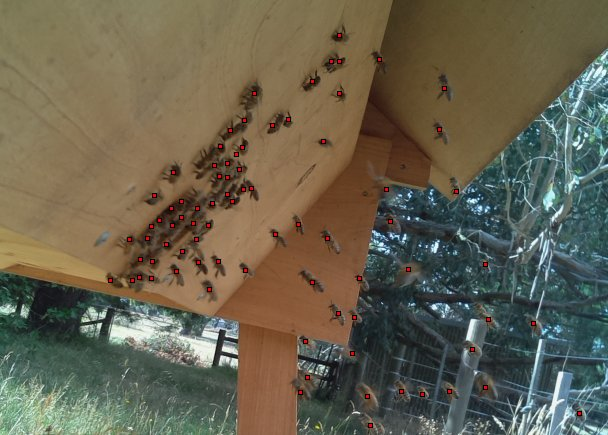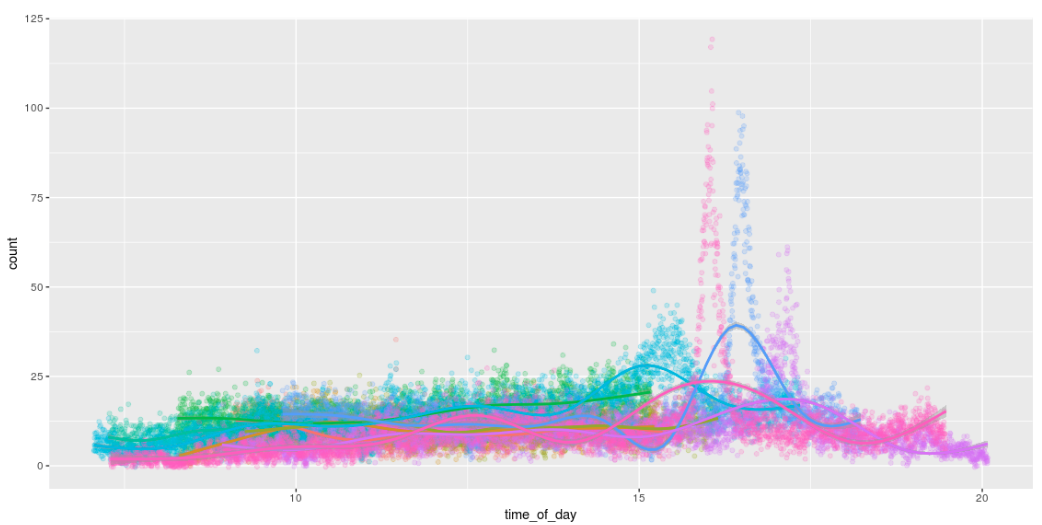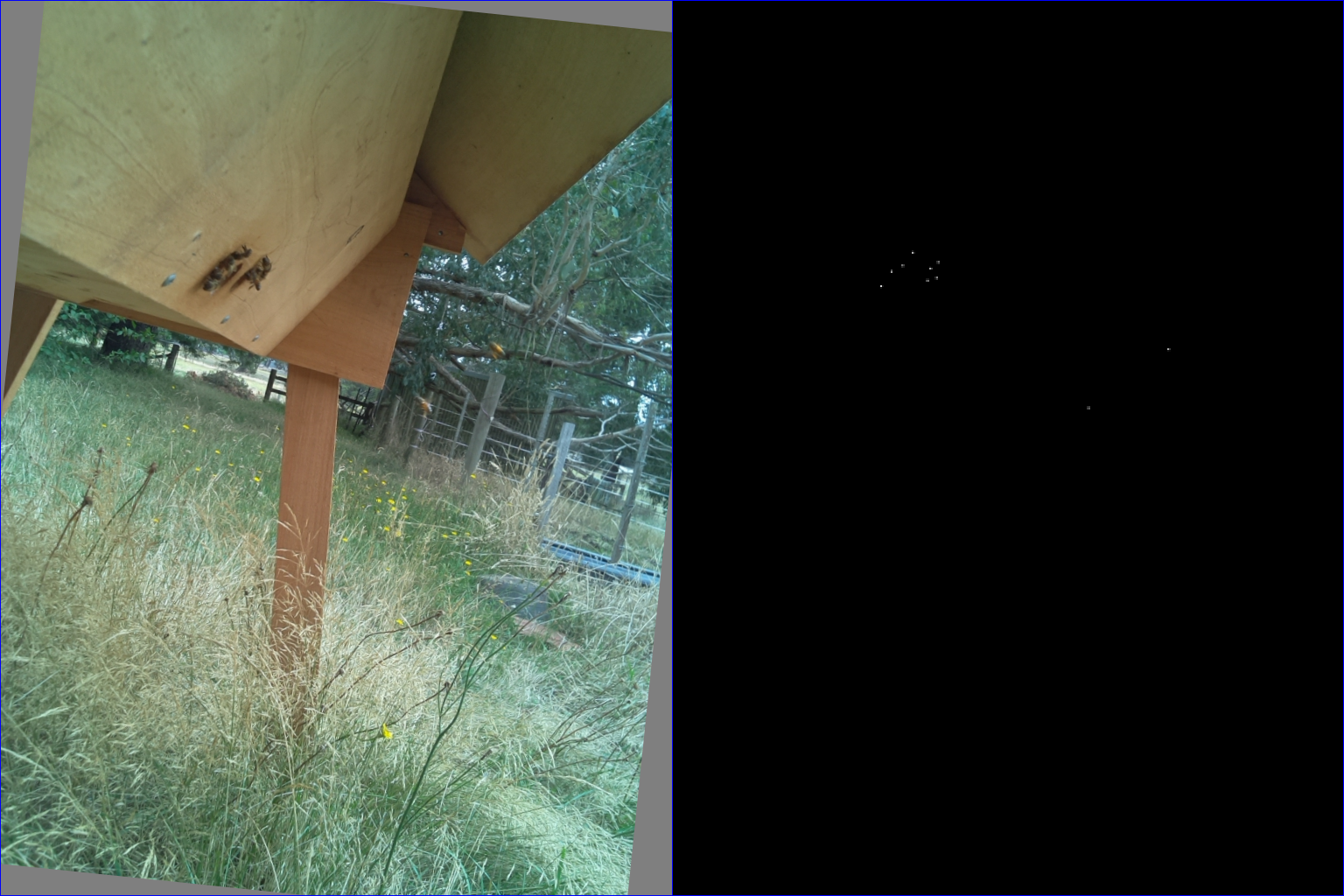BNN v2
unet style image translation from image of hive entrance to bitmap of location of center of bees.
trained in a semi supervised way on a desktop gpu and deployed to run in real time on the hive using either a raspberry pi using a neural compute stick or a je vois embedded smart camera
see this blog post for more info..
here's an example of predicting bee position on some held out data. the majority of examples trained had ~10 bees per image.
the ability to locate each bee means you can summarise with a count. note the spike around 4pm when the bees at this time of year come back to base.
usage
see run_sample_training_pipeline.sh for an executable end to end smoke test walkthrough of these steps (using sample data)
dependencies
code depends in requirements.txt
sudo apt-get install python3-tk python3-pil python3-pil.imagetk python3-matplotlib
sudo pip3 install -r requirements.txt
gathering data
the rasp_pi sub directory includes one method of collecting images on a raspberry pi.
labelling
start by using the label_ui.py tool to manually label some images and create a sqlite label.db
the following command starts the labelling tool for some already labelled (by me!) sample data provided with in this repro.
./label_ui.py \
--image-dir sample_data/training/ \
--label-db sample_data/labels.db \
--width 768 --height 1024
hints
- left click to label the center of a bee
- right click to remove the closest label
- press up to toggle labels on / off. this can help in tricky cases.
- use left / right to move between images. it's often helpful when labelling to quickly switch back/forth between images to help distinguish background
- use whatever system your OS provides to zoom in; e.g. in ubuntu super+up / down
you can merge entries from a.db into b.db with merge_db.py
./merge_dbs.py --from-db a.db --into-db b.db
training
before training we materialise a label.db (which is a database of x,y coords)
into black and white bitmaps using ./materialise_label_db.py
./materialise_label_db.py \
--label-db sample_data/labels.db \
--directory sample_data/labels/ \
--width 768 --height 1024
we can visualise the training data with data.py. this will generate a number of test*png files with
the input data on the left (with data augmentation) and the output labels on the right.
./data.py \
--image-dir sample_data/training/ \
--label-dir sample_data/labels/ \
--width 768 --height 1024
train with train.py.
run denotes the subdirectory for ckpts and tensorboard logs; e.g. --run r12 checkpoints
under ckpts/r12/ and logs under tb/r12.
use --help to get complete list of options including model config, defining validation data and stopping conditions.
e.g. to train for a short time on sample_data run the following... (for a more realistic result we'd want
to train for many more steps on much more data)
./train.py \
--run r12 \
--steps 300 \
--train-steps 50 \
--train-image-dir sample_data/training/ \
--test-image-dir sample_data/test/ \
--label-dir sample_data/labels/ \
--width 768 --height 1024
progress can be visualised with tensorboard (serves at localhost:6006)
tensorboard --log-dir tb
inference
predictions can be run with predict.py.
to specifiy what type of output set one of the following...
--output-label-dbto create a label db; this can be merged with a human labelled db, using./merge_dbs.pyfor semi supervised learning--export-pngs centroidsto export output bitmaps equivalent as those made by./materialise_label_db.py--export-pngs predictionsto export explicit model output (i.e. before connected components post processing)
NOTE: given the above step that only runs a short period on a small dataset we DON'T expect this to give a great result; these instructions are more included to prove the plumbing works...
./predict.py \
--run r12 \
--image-dir sample_data/unlabelled \
--output-label-db sample_predictions.db \
--export-pngs predictions
output predictions can be compared to labelled data to calculate precision recall. (we deem a detection correct if it is within a thresholded distance from a label)
./compare_label_dbs.py --true-db ground_truth.db --predicted-db predictions.db
precision 0.936 recall 0.797 f1 0.861
running on compute stick
after loads of hacking i did eventually get this running on the compute stick. some info is included in this issue with additional background info in this forum post
[update] given how long ago this was, i'm hoping things are easier these days :D
some available datasets
- Jonathan Byrne's to-bee-or-not-to-bee kaggle dataset


